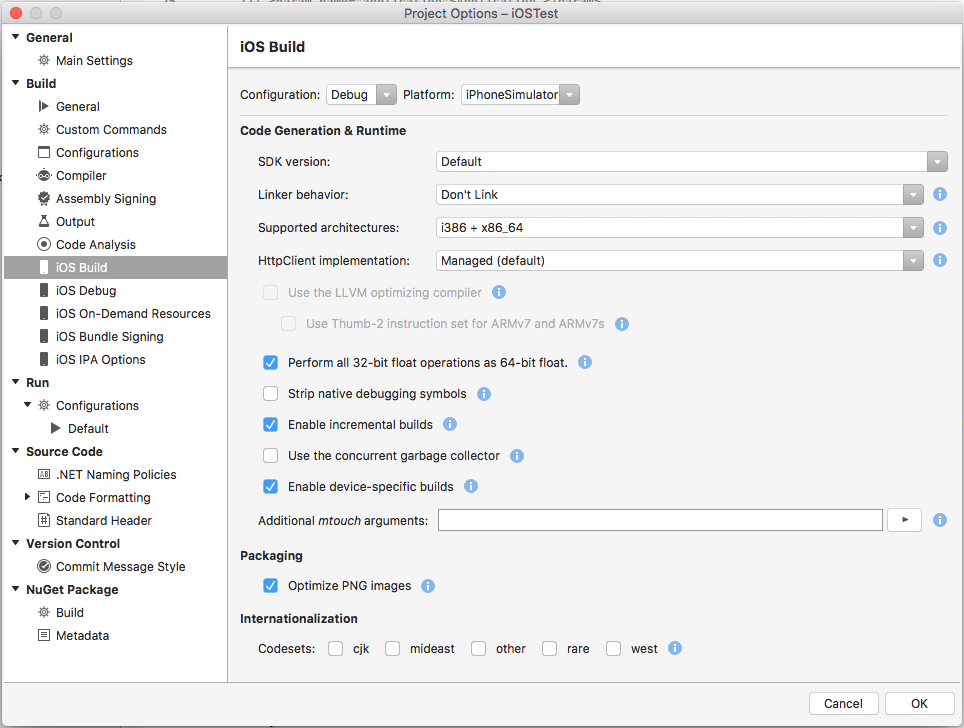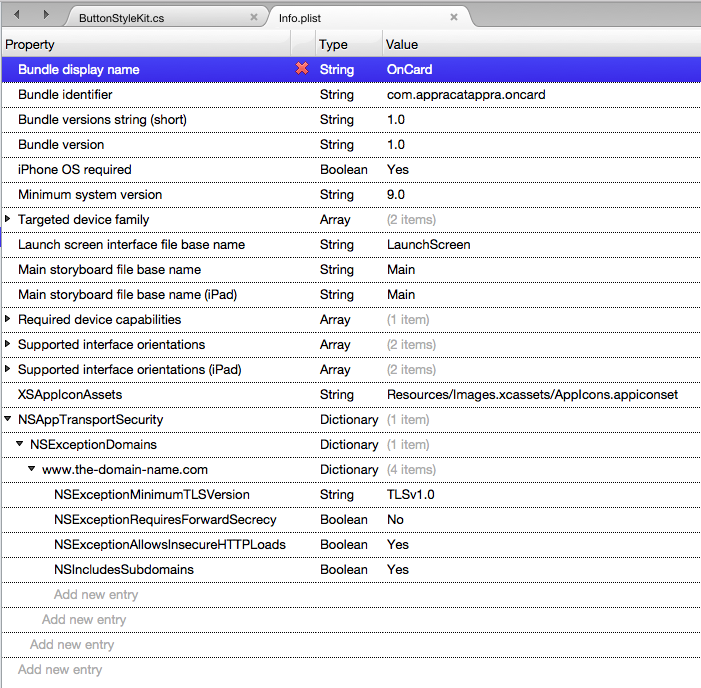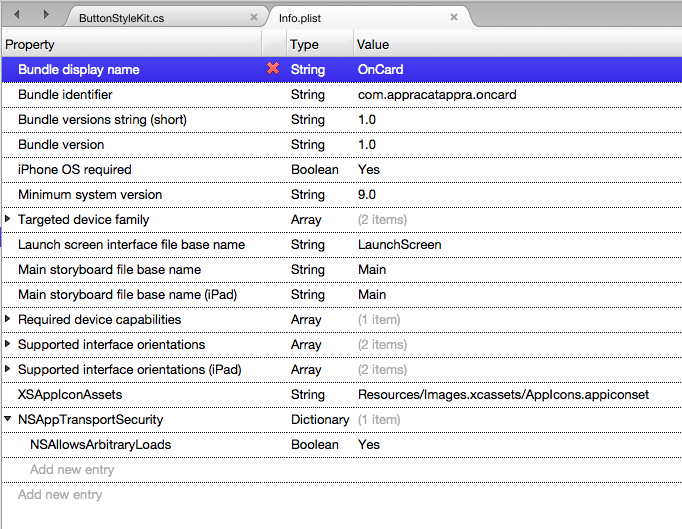App Transport Security in Xamarin.iOS
App Transport Security (ATS) enforces secure connections between internet resources (such as the app's back-end server) and your app.
This article will introduce the security changes that App Transport Security enforces on an iOS 9 app and what this means for your Xamarin.iOS projects, it will cover the ATS configuration options and it will cover how to opt-out of ATS ATS if required. Because ATS is enabled by default, any non-secure internet connections will raise an exception in iOS 9 apps (unless you've explicitly allowed it).
About App Transport Security
As stated above, ATS ensures that all internet communications in iOS 9 and OS X El Capitan conform to secure connection best practices, thereby preventing accidental disclosure of sensitive information either directly through your app or a library that it is consuming.
For existing apps, implement the HTTPS protocol whenever possible. For new Xamarin.iOS apps, you should use HTTPS exclusively when communicating with internet resources. Additionally, high-level API communication must be encrypted using TLS version 1.2 with forward secrecy.
Any connection made with NSUrlConnection, CFUrl or NSUrlSession will use ATS by default in apps built for iOS 9 and OS X 10.11 (El Capitan).
Default ATS Behavior
Since ATS is enabled by default in apps built for iOS 9 and OS X 10.11 (El Capitan), all connections using NSUrlConnection, CFUrl or NSUrlSession will be subject to ATS security requirements. If your connections do not meet these requirement, they will fail with an exception.
ATS Connection Requirements
ATS will enforce the following requirements for all internet connections:
- All connection ciphers must be using forward secrecy. See the list of accepted ciphers below.
- The Transport Layer Security (TLS) protocol must be version 1.2 or greater.
- At least a SHA256 fingerprint with either a 2048 bit or greater RSA key, or a 256 bit or greater Elliptic-Curve (ECC) key must be used for all certificates.
Again, since ATS is enabled by default in iOS 9, any attempt to make a connection that doesn't meet these requirements will result in an exception being thrown.
ATS Compatible Ciphers
The following forward secrecy cipher type are accepted by ATS secured internet communications:
TLS_ECDHE_ECDSA_WITH_AES_256_GCM_SHA384TLS_ECDHE_ECDSA_WITH_AES_128_GCM_SHA256TLS_ECDHE_ECDSA_WITH_AES_256_CBC_SHA384TLS_ECDHE_ECDSA_WITH_AES_256_CBC_SHATLS_ECDHE_ECDSA_WITH_AES_128_CBC_SHA256TLS_ECDHE_ECDSA_WITH_AES_128_CBC_SHATLS_ECDHE_RSA_WITH_AES_256_GCM_SHA384TLS_ECDHE_RSA_WITH_AES_128_GCM_SHA256TLS_ECDHE_RSA_WITH_AES_256_CBC_SHA384TLS_ECDHE_RSA_WITH_AES_128_CBC_SHA256TLS_ECDHE_RSA_WITH_AES_128_CBC_SHA
For more information about working with iOS internet communication classes, please see Apple's NSURLConnection Class Reference or NSURLSession Class Reference.
Supporting ATS in Xamarin.iOS
Because ATS is enabled by default in iOS 9 and OS X El Capitan, if your Xamarin.iOS app or any library or service it is using makes connection to the internet, you'll need to take some action or your connections will result in an exception being thrown.
For an existing app, Apple suggests you support the HTTPS protocol as soon as possible. If you either can't because you are connecting to a 3rd party web service that doesn't support HTTPS or if supporting HTTPS would be impractical, you can opt-out of ATS. See the Opting-Out of ATS section below for more details.
For a new Xamarin.iOS app, you should use HTTPS exclusively when communicating with internet resources. Again, there might be situations (like using a 3rd party web service) where this isn't possible and you'll need to opt-out of ATS.
Additionally, ATS enforces high-level API communication to be encrypted using TLS version 1.2 with forward secrecy. See the ATS Connection Requirements and ATS Compatible Ciphers sections above for more details.
While you might not be familiar with TLS (Transport Layer Security) it is the successor to SSL (Secure Socket Layer) and provides a collection of cryptographic protocols to enforce security over network connections.
The TLS level is controlled by the web service that you are consuming and is therefore outside of the app's control. Both the HttpClient and the ModernHttpClient should automatically use the highest level of TLS encryption supported by the server.
Depending on the server that you are talking to (especially if it is a 3rd party service), you might need to disable forward secrecy or select a lower TLS level. See the Configuring ATS Options section below for more details.
Important
App Transport Security does not apply to Xamarin apps using Managed HTTPClient implementations. It applies to connections using CFNetwork HTTPClient implementations or NSURLSession HTTPClient implementations only.
Setting the HTTPClient Implementation
To set the HTTPClient Implementation used by an iOS app, double-click the Project in the Solution Explorer to open the Project Options. Navigate to iOS Build and select the desired client type under the HttpClient implementation dropdown:

Managed Handler
The Managed handler is the fully managed HttpClient handler that has been shipped with previous versions of Xamarin.iOS and is the default handler.
Pros:
- It is the most compatible with Microsoft .NET and older version of Xamarin.
Cons:
- It is not fully integrated with iOS (e.g it is limited to TLS 1.0).
- It is usually much slower than the native APIs.
- It requires more managed code and creates larger apps.
CFNetwork Handler
The CFNetwork based handler is based on the native CFNetwork framework.
Pros:
- Uses native API for better performance and smaller executable sizes.
- Adds support for newer standards such as TLS 1.2.
Cons:
- Requires iOS 6 or later.
- Not available of watchOS.
- Some HttpClient features and options are not available.
NSUrlSession Handler
The NSUrlSession based handler is based on the native NSUrlSession API.
Pros:
- Uses native API for better performance and smaller executable sizes.
- Adds support for newer standards such as TLS 1.2.
Cons:
- Requires iOS 7 or later.
- Some HttpClient features and options are not available.
Diagnosing ATS Issues
When attempting to connect to the internet, either directly or from a web view in iOS 9, you might get an error in the form:
App Transport Security has blocked a cleartext HTTP (
http://www.-the-blocked-domain.com) resource load since it is insecure. Temporary exceptions can be configured via your app's Info.plist file.
In iOS9, App Transport Security (ATS) enforces secure connections between internet resources (such as the app's back-end server) and your app. Additionally, ATS requires communication using the HTTPS protocol and high-level API communication to be encrypted using TLS version 1.2 with forward secrecy.
Since ATS is enabled by default in apps built for iOS 9 and OS X 10.11 (El Capitan), all connections using NSURLConnection, CFURL or NSURLSession will be subject to ATS security requirements. If your connections do not meet these requirement, they will fail with an exception.
Apple also provides the TLSTool Sample App that can be compiled (or optionally transcoded to Xamarin and C#) and used to diagnose ATS/TLS issues. Please see the Opting-Out of ATS section below for information on how to solve this issue.
Configuring ATS Options
You can configure several of the features of ATS by setting values for specific keys in your app's Info.plist file. The following keys are available for controlling ATS (indented to show how they are nested):
NSAppTransportSecurity
NSAllowsArbitraryLoads
NSAllowsArbitraryLoadsInWebContent
NSExceptionDomains
<domain-name-for-exception-as-string>
NSExceptionMinimumTLSVersion
NSExceptionRequiresForwardSecrecy
NSExceptionAllowsInsecureHTTPLoads
NSRequiresCertificateTransparency
NSIncludesSubdomains
NSThirdPartyExceptionMinimumTLSVersion
NSThirdPartyExceptionRequiresForwardSecrecy
NSThirdPartyExceptionAllowsInsecureHTTPLoads
Each key has the following type and meaning:
- NSAppTransportSecurity (
Dictionary) - Contains all of the setting keys and values for ATS. - NSAllowsArbitraryLoads (
Boolean) - IfYESATS will be disabled for any domain not listed inNSExceptionDomains. For listed domains, the security settings specified will be used. - NSAllowsArbitraryLoadsInWebContent (
Boolean) - IfYESwill allow web pages to load correctly while Apple Transport Security (ATS) protection is still enabled for the rest of the app. - NSExceptionDomains (
Dictionary) - A collection of domains that and the security settings that ATS should use for a given domain. - <domain-name-for-exception-as-string> (
Dictionary) - A collection of exceptions for a given domain (eg.www.xamarin.com). - NSExceptionMinimumTLSVersion (
String) - The minimal TLS version as eitherTLSv1.0,TLSv1.1orTLSv1.2(which is the default). - NSExceptionRequiresForwardSecrecy (
Boolean) - IfNOthe domain does not have to use a cipher with forward security. The default value isYES. - NSExceptionAllowsInsecureHTTPLoads (
Boolean) - IfNO(the default) all communications with this domain must be in theHTTPSprotocol. - NSRequiresCertificateTransparency (
Boolean) - IfYESthe domain’s Secure Sockets Layer (SSL) must include valid transparency data. The default value isNO. - NSIncludesSubdomains (
Boolean) - IfYESthese settings override all subdomains of this domain. The default value isNO. - NSThirdPartyExceptionMinimumTLSVersion (
String) - The TLS version used when the domain is a 3rd party service outside of the developer's control. - NSThirdPartyExceptionRequiresForwardSecrecy (
Boolean) - IfYESa 3rd party domain requires forward secrecy. - NSThirdPartyExceptionAllowsInsecureHTTPLoads (
Boolean) - IfYESthe ATS will allow non-secure communication with 3rd party domains.
Opting-Out of ATS
While Apple highly suggests using the HTTPS protocol and secure communication to internet based information, there might be times that this isn't always possible. For example, if you are communicating with a 3rd party web service or using internet delivered ads in your app.
If your Xamarin.iOS app must make a request to an insecure domain, the following changes to your app's Info.plist file will disable the security defaults that ATS enforces for a given domain:
<key>NSAppTransportSecurity</key>
<dict>
<key>NSExceptionDomains</key>
<dict>
<key>www.the-domain-name.com</key>
<dict>
<key>NSExceptionMinimumTLSVersion</key>
<string>TLSv1.0</string>
<key>NSExceptionRequiresForwardSecrecy</key>
<false/>
<key>NSExceptionAllowsInsecureHTTPLoads</key>
<true/>
<key>NSIncludesSubdomains</key>
<true/>
</dict>
</dict>
</dict>
Inside Visual Studio for Mac, double-click the Info.plist file in the Solution Explorer, switch to the Source view and add the above keys:
If your app needs to load and display web content from non-secure sites, add the following to your app's Info.plist file to allow web pages to load correctly while Apple Transport Security (ATS) protection is still enabled for the rest of the app:
<key>NSAppTransportSecurity</key>
<dict>
<key> NSAllowsArbitraryLoadsInWebContent</key>
<true/>
</dict>
Optionally, you can make the following changes to your app's Info.plist file to completely disable ATS for all domains and internet communication:
<key>NSAppTransportSecurity</key>
<dict>
<key>NSAllowsArbitraryLoads</key>
<true/>
</dict>
Inside Visual Studio for Mac, double-click the Info.plist file in the Solution Explorer, switch to the Source view and add the above keys:
Important
If your application requires a connection to an insecure website, you should always enter the domain as an exception using NSExceptionDomains instead of turning ATS off completely using NSAllowsArbitraryLoads. NSAllowsArbitraryLoads should only be used in extreme emergency situations.
Again, disabling ATS should only be used as a last resort, if switching to secure connections is either unavailable or impractical.
Summary
This article has introduced App Transport Security (ATS) and described the way it enforces secure communications with the internet. First, we covered the changes ATS requires for a Xamarin.iOS app running on iOS 9. Then we covered controlling ATS features and options. Finally, we covered opting out of ATS in your Xamarin.iOS app.

